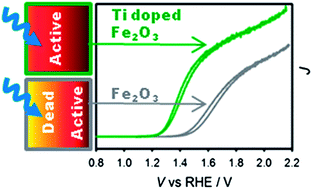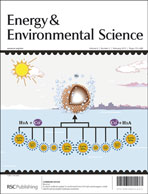Highly photoactive Ti-doped α-Fe2O3 thin film electrodes: resurrection of the dead layer†
Abstract
Uniform thin films of hematite and Ti-doped hematite (α-Fe2O3) were deposited on transparent conductive substrates using atomic layer deposition (ALD). ALD's epitaxial growth mechanism allowed the control of the morphology and thickness of the hematite films as well as the concentration and distribution of Ti atoms. The photoelectrochemical performances of Ti-doped and undoped hematite electrodes were examined and compared under water oxidation conditions. The incorporation of Ti atoms into hematite electrodes was found to dramatically enhance the water oxidation performance, with much greater enhancement found for the thinnest films. An optimum concentration ∼3 atomic% of Ti atoms was also determined. A series of electrochemical, photoelectrochemical and impedance spectroscopy measurements were employed to elucidate the cause of the improved photoactivity of the Ti-doped hematite thin films. This performance enhancement was a combination of improved bulk properties (hole collection length) and surface properties (water oxidation efficiency). The improvement in both bulk and surface properties is attributed to the resurrection of a dead layer by the Ti dopant atoms.


 Please wait while we load your content...
Please wait while we load your content...